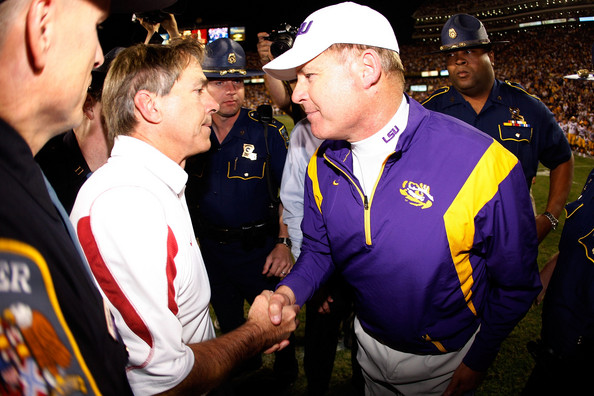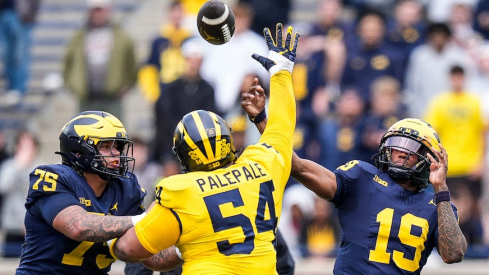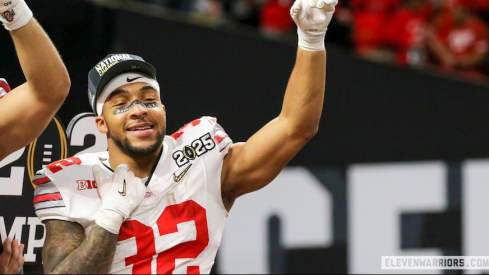 On NLOI Day 2011, these two combined were 19 players above the limit. (Getty)
On NLOI Day 2011, these two combined were 19 players above the limit. (Getty)While you're suddenly re-engaged in Ohio State's conference championship possibilities (thank you, Sparty) the most anticipated game that you'll be hearing about this week isn't even being played until next weekend.
LSU and Alabama are ranked atop the polls and both have this coming weekend off before playing each other on Nov 5, so the rare 1 vs. 2 matchup gets an additional rarity in that it will receive a two-week buildup without the threat of vaporizing by way of an upset.
Sure, you'll consume plenty of thoughts about Ohio State's unexpected B1G reprieve throughout this week, but nationally - aside from requisite lip service - this is the big game.
You're guaranteed to hear about LSU and Alabama during every broadcast this coming Saturday, and rightfully so: It will be the first regular season 1 vs. 2 since Ohio State and Michigan met to end of the 2006 season.
So the oddity of this organically happening outside of the annually-manufactured BCS finale will surely grab the marquee storyline. The "Saban Bowl" element to this matchup - Les Miles took over at LSU for Nick Saban, who now coaches at Alabama - will be the subheader.
The storyline that probably won't make it anywhere near the national discussion is that Saban and Miles each play the recruiting game with a stacked deck: For every four players that almost every other program in the country admits to school, Alabama and LSU each take in five.
While it won't happen, the discussion of oversigning should be one of the storylines for this particular game. LSU and Alabama should be ranked at or near the top of the polls, and every year - not just in 2011.
Both programs have top-tier head coaches and both schools - unlike the one in Columbus - are at or above the Southeastern Conference's pay grade for proven assistant coaches and coordinators. Baton Rouge and Tuscaloosa are practically required to be on every elite high school recruit's list of possibilities.
But what ensures that LSU and Alabama should be among the elite of the elite is that both have installed a system that gives them significantly less recruiting risk than most of their competitors in recruiting.
Oversigning recruits every year has given both schools built-in second and third-chances where talent acquisition is concerned. They get refunds on their bad bets, and their depth charts are proof that it works.
If you're somehow unfamiliar with how oversigning works, here's the one-sentence summary: Oversigning programs like Alabama and LSU purge their 85-man rosters of underperforming players by either citing medical hardship, issuing grayshirts, encouraging transfers, natural attrition or - when the summer is over and the season is about to start with still too many scholarship players on the roster - abruptly pulling enough scholarships to get down to 85.
There's an entire web site devoted to shedding light on this practice, but it is angled more toward the ethics behind operating on the premise of a renewable one-year scholarship that can expire, rather than a four-year commitment to a kid who accepts a scholarship offer.
The latter group of collegians, which includes recruiting misses, occupies valuable spaces in the rosters of most football programs in the country.
At LSU and Alabama, nothing is guaranteed: The players that pan out stay on campus. The ones that aren't good enough might find out over the summer that they need to find another school.
How much competitive advantage is gained? Alabama's closest game this year was a 16-point laugher at State College. LSU has cruised past five ranked teams by an aggregate score of 192-75. And it's not just this year - at least one of these two teams has been ranked in the top five in six of the past seven meetings.
Neither seems to ever have significant holes or weaknesses, largely because they can be addressed very quickly through oversigning.
 OBC: The SEC East's answer to the entire SEC West.
OBC: The SEC East's answer to the entire SEC West.Every four years LSU, Alabama and the rest of the SEC West sign what amounts to five recruiting classes. That gives them an entire bad year's worth of mulligans for players who end up being lousier than their high school tapes might have indicated. With those second chances, oversigning schools like LSU and Alabama often find their difference makers.
It only takes a couple of extra guys to make the leap to championship contention. Look at Cam Newton, who was booted from Florida for both academic fraud and property theft.
He ended up signing at Auburn as part of 32-man class. Those seven extra signees above the 25-man limit that is allowed to enroll were insurance policies for players - potentially, like Newton - that are likely to flake, flunk or get kicked out of school.
Newton was a gamble that paid off. Auburn, like Arkansas, Ole Miss and the SEC West as a whole sign more players to choose from when it comes to determining the two-deep.
Look at Duron Carter, Ohio State legacy who was kicked out of school for, among his other hallmarks of laziness and entitlement, flunking survey courses. Alabama could afford to give him a second chance last April, well after National Signing Day - in part because of the unnatural attrition that happens in Tuscaloosa every summer.
What this means is that one Crimson Tide player who was on the Alabama roster last April suddenly found himself out of school before September to make room for Carter, who predictably isn't academically eligible to play this season because he's still Duron Carter.
If you don't think an extra player or five doesn't make much of a difference, look at Ohio State 110th-ranked offense without Terrelle Pryor's natural physical ability keeping Nick Siciliano anonymous. Oversigning at Ohio State could mean curbing Jim Bollman's failed lineman experiments that end up playing both sides of the line on the scout team for five years.
As long as players are clearly informed up front that scholarships are a one-year deal and not a four-year commitment by the school, it shouldn't be a matter of ethics. However, the Big Ten has eliminated that course of roster management entirely by placing a hard cap on the number of players that can be signed annually.
The SEC just pays the topic lip service, and that's its prerogative: That conference is about winning national championships and being the best football conference in the country.
It has the best head coaches, the highest-paid assistants, the most passionate, unwashed fan base in America and most of its teams possess a mathematical, almost insurmountable competitive advantage when it comes to roster management.
Since 2006 when Ohio State and Michigan were ranked 1 and 2 respectively, SEC schools have averaged 18 more signees in that span over their Big Ten counterparts. When Ohio State played Arkansas in last year's Sugar Bowl, the Razorbacks had signed 36 more players than Ohio State had during the same four-year timeframe.
Sure, there were five tattooed Buckeyes that probably shouldn't have played that night, but really, who had the competitive advantage?
The conference's commitment to winning means that the intersectional post-game S-E-C chants that the rest of America loves so much are not going anywhere anytime soon. It also means that the streak of Alabama vs. LSU matchups where both teams are highly-ranked isn't likely to end as long as each school's roster is culled and refilled in the superfluous manner that they are.
Oversigning shouldn't necessarily be eliminated outright, just altered for fairness to these athletes. Matchups like LSU and Alabama in two weeks are what we all want to see, and these teams have armed themselves to the teeth in part because of how they exploit recruiting loopholes.
Instead of banning oversigning, change the rules for recruiting to openly reflect the rest of the meat market mentality and operation that FBS college football has been for decades. That isn't ever going to change, so the NCAA might as well embrace it.
Implement a National Cutdown Day the last week of January - prior to National Letter of Intent Day - to give the players who would normally be ushered out the back door, given bogus medical hardships or grayshirted over the summer the chance to transfer anywhere else that's willing to take them.
Allow them to play for their new school that fall instead of sitting out for a year. Install the SEC's 28-man signing day limit across the country. Level the playing field without screwing the players by sending them to directional Alabama schools at the last minute.
Simply pull oversigning out of the shadows and make it an open, timely, equitable and fair process for the players involved. The result would be a level playing field that provides second chances not just for programs, but for players as well. It will also make college football's third season that much more interesting.
Until the rules around oversigning are changed, Alabama and LSU will continue to be uniquely wonderful to watch. The idea of two loaded teams like this playing each other is the hallmark of great college football, but this colossal matchup didn't exactly occur by chance.
At some point during the buildup to the game over the next two weeks, some analyst - probably Kirk Herbstreit, because he always does this - will fawn over the immense depth and sheer volume of athletes that both LSU and Alabama possess on both sides of the ball.
And he'll be absolutely right. But he won't tell you how it really happened.

